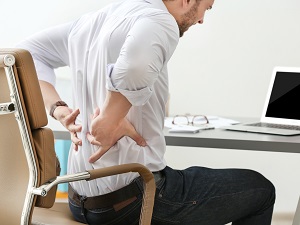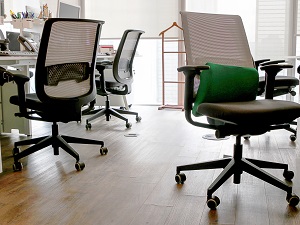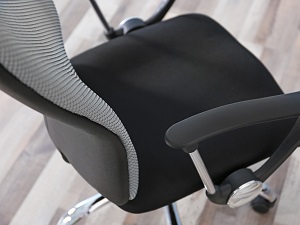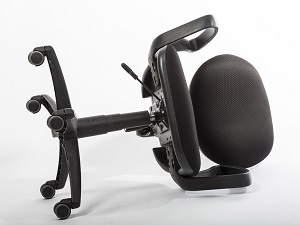Sitting in and using a chair at work should not be dangerous, so don’t add unnecessary risk to a fairly safe activity.

Always keep the entire base of the chair in contact with the floor. If the chair is wobbly, tilted, or unstable do not continue using the chair until it is fixed or replaced.
Do not lean back in the chair by either lifting the front legs off the ground or forcing the back of the chair into a horizontal position. This can result in the chair slipping or sliding out from under you causing injury.
Do not lean too far forward in the chair or sit too far forward on the edge of the seat because this can also result in an unexpected tip-over.
Never run electrical cables (including extension cords) under rugs, in a high-traffic area, or where chairs can roll over them. Cables that become damaged from a chair can cause electric shocks and present a fire hazard.
OSHA Standard 1910.305(a)(2)(x) Flexible cords and cables shall be protected from accidental damage, as might be caused, for example, by sharp corners, projections, and doorways or other pinch points.
Do not play pranks using anyone else’s chair and horseplay with chairs on wheels is prohibited.
To prevent back injuries, avoid forceful twisting and turning motions while sitting. For example, don’t twist in your office chair to open a heavy filing cabinet behind you.

When it’s time to put together a brand-new office chair read the instruction manual first and follow all the directions for assembly.
Ensure each piece of the chair is accounted for, put together in order, properly placed, and securely tightened. If not all the pieces were used during the chair assembly consult the instruction manual again because a leftover part may mean the chair you just built is incomplete and unsafe.
Once the chair is assembled and upright, make sure all the legs/wheels are in stable contact with the floor. Before sitting in any newly assembled chair for the first time, double-check each wheel to ensure that they are all fully inserted into the base and securely attached. If the chair has a tilting function, make sure it is tight enough for a controlled motion so the first try in the new chair doesn’t send you flying backwards.

Always select chairs with a five-legged base as the safest choice with the strongest foundation. Chairs with four or fewer legs at the base may provide inadequate support and are more prone to tipping.
Every six months, or on a regular basis, make sure to check the chair you are using for wear and tear or damage. Tighten-up any parts that have come loose and replace any parts that have become worn out.
Do not use any chair that is not safe any longer! Do not pass around a damaged chair because it seems funny.
If you don’t know what the procedure is to get a chair removed from the work area or replaced if a new one is needed, please ask.

The chair that is being used should have casters that are appropriate for the type of flooring at the workstation.
Getting into the best ergonomic position at the workstation can be difficult if the chair doesn’t have the right kind of wheels. This extra effort of pushing the chair around on a daily basis can lead to muscle strain and fatigue as well as a damaged chair or floors.
Keep in mind that some wheeled chairs may not be suitable on completely smooth flooring surfaces because many chair casters are designed for use on carpets.
Always read the owner’s manual and replace the casters, or add a chair mat under the chair, to ensure the wheels and the flooring are compatible.
OSHA Standard 1910.23(c)(13) Ladders are not placed on boxes, barrels, or other unstable bases to obtain additional height.
OFFICE CHAIRS ARE NOT STEP STOOLS.
Do not use any office chair as a ladder. It may be tempting to step on a chair to save time, but it is not safe.
Never place any kind of step stool or ladder on an office chair (or anything else!) to gain additional height for the ladder.

While sitting and working at a desk, for ergonomic comfort it's important to remain in a neutral position that reduces stress and strain on the body.
Use a chair that provides good lumbar support and always sit upright against the back of the chair while maintaining good posture. Keep your shoulders relaxed (not tense or raised) and your elbows close to your body. Your hands, wrists, and forearms should be straight and about parallel to the floor.
Maintain good posture so your head remains level, balanced, and forward-facing while working. Avoid leaning in towards the computer monitor to avoid strain on your neck.
Keep the top of the computer monitor at or just below eye level. This allows the eyes to gravitate naturally toward the center of the screen. The viewing distance to the monitor should be 18 – 30 inches to minimize eye strain.
Your thighs and hips should be supported and just about parallel to the floor with your knees at about the same height and your feet slightly forward and flat on the floor. If needed, adjust the height of the chair or use a footrest placed under the desk.
Keep frequently used office supplies within close reach to avoid awkward overreaching or twisting.

To prevent stress and strain on the body, avoid remaining in the same seated work position for prolonged periods of time. Vary your work tasks and take short breaks throughout the day to rest muscles and increase blood circulation.
Periodically take time to stretch your hands, arms, and fingers, stand up to stretch, and take short walks. But, don’t stretch so far backwards in your chair that you end up tipping backwards!
Make small adjustments to the chair or backrest, as needed, and consider trying to complete some of your daily work tasks while standing.
Computer or desk work that can lead to discomfort is most often caused by:
Repetitive movements. Do you type for long periods without rest?
Awkward posture. Is your neck, or your wrist, bent at a sharp angle while sitting?
Static posture. Do you sit for long periods without getting up or stretching?

.jpg)



.jpeg)